
Information Systems
.pdf
PART
• 1 •
Chapter 1 An Introduction to Information Systems
Chapter 2 Information Systems in Organizations
Copyright © 2005 by Course Technology. All rights reserved.This publication is protected by federal copyright law. No part of this publication may be reproduced without prior permission in writing from Course Technology. Some of the product names and company names have been used for identification purposes only and may be trademarks or registered trademarks of their respective manufactures and sellers.

CHAPTER An Introduction to
• 1 • |
Information Systems |
|
PRINCIPLES
■The value of information is directly linked to how it helps decision makers achieve the organization’s goals.
■Models, computers, and information systems are constantly making it possible for organizations to improve the way they conduct business.
■Knowing the potential impact of information systems and having the ability to put this knowledge to work can result in a successful personal career, organizations that reach their goals, and a society with a higher quality of life.
■System users, business managers, and information systems professionals must work together to build a successful information system.
■Information systems must be applied thoughtfully and carefully so that society, business, and industry can reap their enormous benefits.
LEARNING OBJECTIVES
■Discuss why it is important to study and understand information systems.
■Distinguish data from information and describe the characteristics used to evaluate the quality of data.
■Name the components of an information system and describe several system characteristics.
■Identify the basic types of models and explain how they are used.
■List the components of a computer-based information system.
■Identify the basic types of business information systems and discuss who uses them, how they are used, and what kinds of benefits they deliver.
■Identify the major steps of the systems development process and state the goal of each.
■Describe some of the threats to security and privacy that information systems and the Internet can pose.
■Discuss the expanding role and benefits of information systems in business and industry.
Copyright © 2005 by Course Technology. All rights reserved.This publication is protected by federal copyright law. No part of this publication may be reproduced without prior permission in writing from Course Technology. Some of the product names and company names have been used for identification purposes only and may be trademarks or registered trademarks of their respective manufactures and sellers.
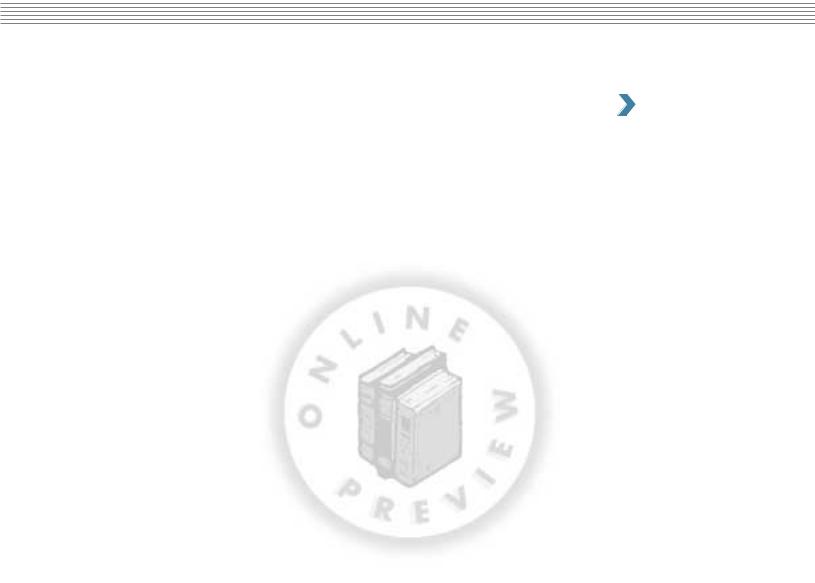
An Introduction to Information Systems | Chapter 1 |
3 |
 INFORMATION SYSTEMS IN THE GLOBAL ECONOMY
INFORMATION SYSTEMS IN THE GLOBAL ECONOMY  BOEHRINGER INGELHEIM, GMBH, GERMANY
BOEHRINGER INGELHEIM, GMBH, GERMANY
Lean and Mean with Information Systems
If a business owner could foresee the future, decisions would be easy to make and involve little risk. Unfortunately, crystal balls, tarot cards, and tea leaves have proven useless to business decision makers. Since they can’t see into the future, their goal is to find out what is currently happening in their business. For a small-business owner, one who is involved in every transaction, staying abreast of the state of the business is fairly straightforward. But as businesses grow and diversify, it becomes increasingly difficult to access current information on which to base decisions. Information systems provide a solution—open- ing lines of communication between all business units and providing a continuous stream of up-to-the-second information to support fast strategic decision making.
Boehringer Ingelheim is among the world’s 20 largest pharmaceutical companies. A giant company with $7.6 billion in revenue and 32,000 employees in 60 nations, Boehringer has diversified into segments that include manufacturing and marketing pharmaceuticals (such as prescription medicines and consumer healthcare products), products for industrial customers (such as chemicals and biopharmaceuticals), and animal health products.
The sheer size of the company was slowing the flow of information to decision makers in the organization. “I want to be told where I stand and where we are heading,” says Holger Huels, chief financial officer, “I like to [be able to] see negative trends and counter them as fast as possible.” With each of the company’s segments using diverse information systems, it took a significant amount of time to collect and combine all of the financial records. Each month the accounting department would spend three days collecting and analyzing printed reports to create the company’s monthly report.
Top managers decided to totally revamp the company’s systems with state- of-the-art information systems from SAP, the world’s largest enterprise software company. It took 14 months to roll out the new system, and many employees needed intensive training. In the end, the results were well worth the investment in time and money. The software provided a standard system used across all of Boehringer’s business segments and offered convenient Web access to current information. Boehringer is now able to complete monthly reports just two hours after the close of business at the end of each month. The new system has made the accounting department much more productive, allowing staff to run up-to- date reports whenever needed.
Boehringer is committed to providing employees at all levels of the company with access to the applications and information they need to meet their objectives. About one third of Boehringer’s employees do their work outside the office. To provide its mobile workforce with up-to-the-minute data, the company deployed software from BackWeb Technologies, which allows access to current sales information through a Web portal and a custom Web interface, wherever employees travel. With the new system, Boehringer’s employees can access and change information presented in the portal when they are offline, with updates later when they log on.
Copyright © 2005 by Course Technology. All rights reserved.This publication is protected by federal copyright law. No part of this publication may be reproduced without prior permission in writing from Course Technology. Some of the product names and company names have been used for identification purposes only and may be trademarks or registered trademarks of their respective manufactures and sellers.

4 |
Part 1 | An Overview |
Why Learn About
Information
Systems?
information system (IS)
A set of interrelated components that collect, manipulate, store, and disseminate data and information and provide a feedback mechanism to meet an objective.
By the time Boehringer was finished with its technology makeover, the company had implemented over seven new interconnected information systems and invested millions in hardware, software, databases, telecommunications, and training. But the investment has paid off. Employees can now access up-to-date organization-wide information, wherever they may be, with the click of a mouse. And decision makers can react as nimbly and quickly to changes as many of Boehringer’s smaller competitors.
As you read this chapter, consider the following:
•In designing its new information systems, what do you think were Boehringer’s most critical goals and considerations?
•How are hardware, software, databases, telecommunications, people, and procedures used in Boehringer’s information system to provide valuable data?
Information systems are used in almost every imaginable career area. Sales representatives use information systems to advertise products, communicate with customers, and analyze sales trends. Managers use them to make multimillion-dollar decisions, such as deciding to build a new manufacturing plant or research a new cancer drug. Corporate lawyers use information systems to develop contracts and other legal documents for their firm. From a small music store to huge multinational companies, businesses of all sizes could not survive without information systems to perform accounting and finance operations. Regardless of your college major or chosen career, you will find that information systems are indispensable tools to help you achieve your career aspirations. Learning about information systems can help you get your first job, obtain promotions, and advance your career. Why learn about information systems? What is in it for you? Learning about information systems will help you achieve your goals! In addition, most sections in this chapter are covered in complete chapters later in this book. For example, the sections in this chapter on hardware, software, databases, telecommunications, e-commerce and m-commerce, transaction processing and enterprise resource planning, information and decision support, special purpose systems, systems development, and ethical and societal issues become complete chapters in the rest of the book. Let’s get started by exploring the basics of information systems.
An information system (IS) is a set of interrelated components that collect, manipulate, store, and disseminate data and information and provide a feedback mechanism to meet an objective. The feedback mechanism helps organizations achieve their goals, such as increasing profits or improving customer service.
We all interact daily with information systems, both personally and professionally. We use automatic teller machines at banks, checkout clerks scan our purchases using bar codes and scanners, we access information over the Internet, and we get information from kiosks with touchscreens. Major Fortune 500 companies are spending in excess of $1 billion per year on information technology. In the future, we will depend on information systems even more. Knowing the potential of information systems and having the ability to put this knowledge to work can result in a successful personal career, organizations that reach their goals, and a society with a higher quality of life.
Computers and information systems are constantly changing the way organizations conduct business. They are becoming fully integrated into our lives, businesses, and society. They can help organizations carry on daily operations (operational systems). For example, WalMart uses operational systems to pull supplies from distribution centers and ultimately suppliers, stock shelves, and push out products and services through customer purchases. Computer and information systems also act as command and control systems that monitor processes and help supervisors control them. For example, air traffic control centers use computers and information systems as command and control centers to monitor and direct planes in their air space.
Copyright © 2005 by Course Technology. All rights reserved.This publication is protected by federal copyright law. No part of this publication may be reproduced without prior permission in writing from Course Technology. Some of the product names and company names have been used for identification purposes only and may be trademarks or registered trademarks of their respective manufactures and sellers.

An Introduction to Information Systems | Chapter 1 |
5 |
Information systems are everywhere. A customer at the gas pump waives a keychain tag at a reader that sends the information to a network to verify the customer’s profile and credit information. The terminal processes the transaction, prints a receipt, and the customer’s credit/check card is automatically billed.
(Source: Courtesy of Texas
Instruments, Inc. All Rights
Reserved.)
Today we live in an information economy. Information itself has value, and commerce often involves the exchange of information, rather than tangible goods. Systems based on computers are increasingly being used to create, store, and transfer information. Investors are using information systems to make multimillion-dollar decisions, financial institutions are employing them to transfer billions of dollars around the world electronically, and manufacturers are using them to order supplies and distribute goods faster than ever before. Computers and information systems will continue to change our society, our businesses, and our lives. In this chapter, we present a framework for understanding computers and information systems and discuss why it is important to study information systems. This understanding will help you unlock the potential of properly applied IS concepts.
INFORMATION CONCEPTS
Information is a central concept throughout this book. The term is used in the title of the book, in this section, and in almost every chapter. To be an effective manager in any area of business, you need to understand that information is one of an organization’s most valuable and important resources. This term, however, is often confused with the term data.
Data Versus Information
Data consists of raw facts, such as an employee’s name and number of hours worked in a week, inventory part numbers, or sales orders. As shown in Table 1.1, several types of data can be used to represent these facts. When these facts are organized or arranged in a meaningful manner, they become information. Information is a collection of facts organized in such a way that they have additional value beyond the value of the facts themselves. For example, a particular manager might find the knowledge of total monthly sales to be more suited to his or her purpose (i.e., more valuable) than the number of sales for individual sales representatives. Providing information to customers can also help companies increase revenues and profits.
data
Raw facts, such as an employee’s name and number of hours worked in a week, inventory part numbers, or sales orders.
information
A collection of facts organized in such a way that they have additional value beyond the value of the facts themselves.
Copyright © 2005 by Course Technology. All rights reserved.This publication is protected by federal copyright law. No part of this publication may be reproduced without prior permission in writing from Course Technology. Some of the product names and company names have been used for identification purposes only and may be trademarks or registered trademarks of their respective manufactures and sellers.
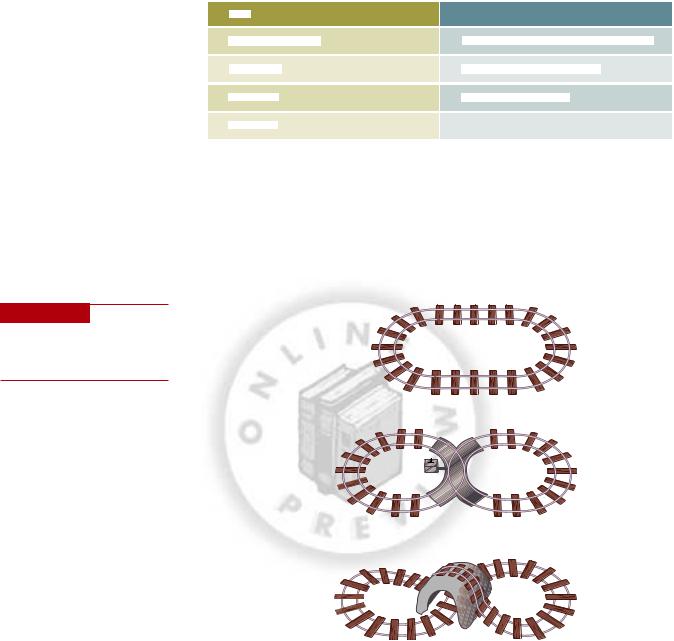
6 |
Part 1 | |
An Overview |
|
|
|
|
|
|
|||||||||||
|
|
|
|
|
|
|
|
|
|
|
|
|
|
|
|
|
|
||
|
Table 1.1 |
|
|
|
|
|
|
|
|
|
|
|
|
|
|
|
|
|
|
|
|
|
|
|
Data |
|
|
|
|
|
Represented By |
||||||||
|
|
|
|
|
|
||||||||||||||
|
|
|
|
||||||||||||||||
Types of Data |
|
|
|
|
|
|
|
|
|
|
|
|
|
|
|
|
|||
Alphanumeric data |
|||||||||||||||||||
|
|
|
|
Numbers, letters, and other characters |
|||||||||||||||
|
|
|
|
|
|
|
|
|
|
|
|
|
|
|
|||||
|
|
|
|
|
|
|
|
|
|
|
|
|
|
|
|
|
|
||
|
|
|
|
|
|
Image data |
|
Graphic images and pictures |
|||||||||||
|
|
|
|
|
|
|
|
|
|
|
|
|
|||||||
|
|
|
|
|
|
Audio data |
|
Sound, noise, or tones |
|||||||||||
|
|
|
|
|
|
|
|
|
|
Moving images or pictures |
|||||||||
|
|
|
Video data |
||||||||||||||||
Data represents real-world things. As we have stated, data—simply raw facts—has little value beyond its existence. For example, consider data as pieces of railroad track in a model railroad kit. In this state, each piece of track has little value beyond its inherent value as a single object. However, if some relationship is defined among the pieces of the track, they will gain value. By arranging the pieces of track in a certain way, a railroad layout begins to emerge (see Figure 1.1a). Information is much the same. Rules and relationships can be set up to organize data into useful, valuable information.
Figure 1.1
Defining and Organizing
(a)
Relationships Among Data
Creates Information
(b)
(c)
process
A set of logically related tasks performed to achieve a defined outcome.
The type of information created depends on the relationships defined among existing data. For example, the pieces of track could be rearranged to form different layouts (see Figure 1.1b). Adding new or different data means relationships can be redefined and new information can be created. For instance, adding new pieces to the track can greatly increase the value—in this case, variety and fun—of the final product. We can now create a more elaborate railroad layout (see Figure 1.1c). Likewise, our manager could add specific product data to his sales data to create monthly sales information broken down by product line. This information could be used by the manager to determine which product lines are the most popular and profitable.
Turning data into information is a process, or a set of logically related tasks performed to achieve a defined outcome. The process of defining relationships among data to create useful information requires knowledge. Knowledge is an awareness and understanding of a set of information and the ways that information can be made useful to support a specific
Copyright © 2005 by Course Technology. All rights reserved.This publication is protected by federal copyright law. No part of this publication may be reproduced without prior permission in writing from Course Technology. Some of the product names and company names have been used for identification purposes only and may be trademarks or registered trademarks of their respective manufactures and sellers.
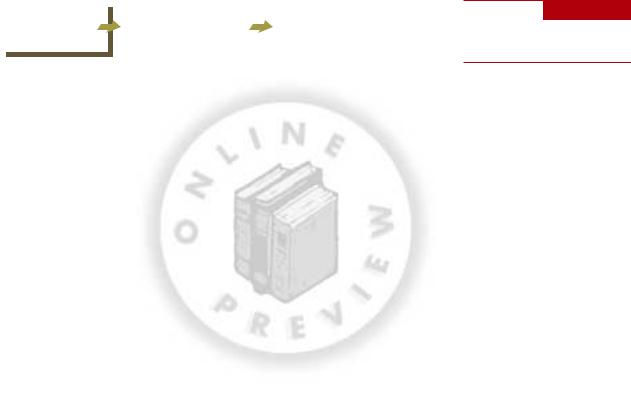
An Introduction to Information Systems | Chapter 1 |
7 |
task or reach a decision. Part of the knowledge needed for building a railroad layout, for instance, is understanding how large an area is available for the layout, how many trains will run on the track, and how fast they will travel. The act of selecting or rejecting facts according to their relevancy to particular tasks is also based on a type of knowledge used in the process of converting data into information. Therefore, information can be considered data made more useful through the application of knowledge. In some cases, data is organized or processed mentally or manually. In other cases, a computer is used. In the earlier example, the manager could have manually calculated the sum of the sales of each representative, or a computer could calculate this sum. What is important is not so much where the data comes from or how it is processed but whether the results are useful and valuable. This transformation process is shown in Figure 1.2.
|
|
|
The transformation process |
|
|
|
|
|
|
|
|
|
|
|
|
Data |
|
|
(applying knowledge by |
|
|
Information |
|
|
|
selecting, organizing, and |
|
|
|
||
|
|
|
|
|
|
|
|
|
|
|
manipulating data) |
|
|
|
|
|
|
|
|
|
|
|
|
|
|
|
|
|
|
|
|
knowledge
An awareness and understanding of a set of information and ways that information can be made useful to support a specific task or reach a decision.
Figure 1.2
The Process of Transforming Data into Information
The Characteristics of Valuable Information
To be valuable to managers and decision makers, information should have the characteristics described in Table 1.2. These characteristics also make the information more valuable to an organization. Many organizations and shipping companies, for example, are able to determine the exact location of inventory items and packages in their systems. Recently, the U.S. Army Materiel Command tagged all its cargo and food shipments with radio-frequency identification chips for shipment to the Middle East. Because of the easy electronic retrieval of information from the tags, the time needed to take inventory of the cargo when it arrived was reduced from the usual 2 to 3 days to just 22 minutes.1 In addition, if an organization’s information is not accurate or complete, people can make poor decisions, costing organizations and individuals thousands, or even millions, of dollars. Many believe, for example, that the collapse of energy-trading firm Enron in the early 2000s was a result of inaccurate accounting and reporting information, which led investors and employees alike to misjudge the actual state of the company’s finances and suffer huge personal losses. Some believe that Enron’s inaccurate accounting was intentional and designed to deceive employees and investors and not a simple accounting mistake. As another example, if an inaccurate forecast of future demand indicates that sales will be very high when the opposite is true, an organization can invest millions of dollars in a new plant that is not needed. Furthermore, if information is not pertinent to the situation, not delivered to decision makers in a timely fashion, or too complex to understand, it may be of little value to the organization.
Useful information can vary widely in the value of each of these quality attributes. For example, with market-intelligence data, some inaccuracy and incompleteness is acceptable, but timeliness is essential. Market intelligence may alert us that our competitors are about to make a major price cut. The exact details and timing of the price cut may not be as important as being warned far enough in advance to plan how to react. On the other hand, accuracy, verifiability, and completeness are critical for data used in accounting for the use of company assets such as cash, inventory, and equipment.
The Value of Information
The value of information is directly linked to how it helps decision makers achieve their organization’s goals. For example, the value of information might be measured in the time required to make a decision or in increased profits to the company. Consider a market forecast that predicts a high demand for a new product. If market forecast information is used to develop the new product and the company is able to make an additional profit of $10,000, the value of this information to the company is $10,000 minus the cost of the information. Valuable information can also help managers decide whether to invest in additional information systems and technology. A new computerized ordering system may cost $30,000,
Copyright © 2005 by Course Technology. All rights reserved.This publication is protected by federal copyright law. No part of this publication may be reproduced without prior permission in writing from Course Technology. Some of the product names and company names have been used for identification purposes only and may be trademarks or registered trademarks of their respective manufactures and sellers.
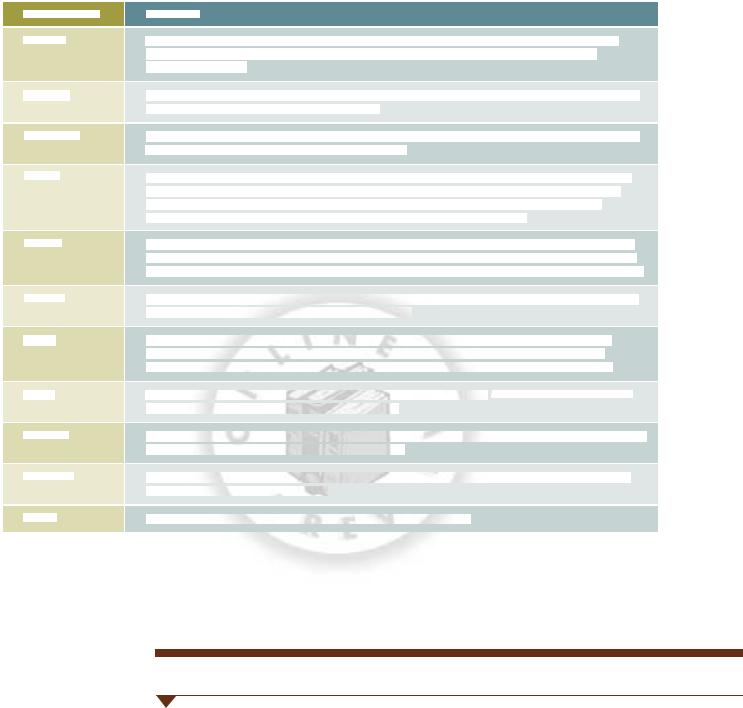
8 |
|
|
|
|
|
|
|
|
Part 1 | An Overview |
|||||||||||||||||||||||||||||||||||||||||||||
|
|
|
|
|
|
|
|
|
|
|
|
|
|
|
|
|
|
|
|
|
|
|
|
|
|
|
|
|
|
|
|
|
|
|||||||||||||||||||||
|
|
|
|
Characteristics |
|
Definitions |
||||||||||||||||||||||||||||||||||||||||||||||||
|
|
|
|
|
|
|
|
|
|
|
|
|
|
|
|
|
|
|
|
|
|
|
|
|
|
|
|
|
|
|
|
|
|
|
|
|
|
|
|
|
|
|
|
|
|
|
|
|
|
|
|
|
|
|
|
|
|
Accurate |
|
|
|
|
|
|
Accurate information is error free. In some cases, inaccurate information is generated because |
||||||||||||||||||||||||||||||||||||||||||||
|
|
|
|
|
|
|
|
|
|
|
|
|
|
|
|
|
|
|
|
|
|
|
|
|
|
|
|
|
|
|
|
|
|
|
|
|
|
|
|
|
|
|
|
|
|
|
|
|
|
|
|
|
|
|
|
|
|
|
|
|
|
|
|
|
|
|
|
|
|
|
|
|
|
|
|
|
|
in accurate data is fed into the transformation process (this is commonly called garbage in, |
|
|
|
|
|
|
|
|
|
|
|||||||||||||||||||||
|
|
|
|
|
|
|
|
|
|
|
|
|
|
|
|
|
|
|
|
|
|
|
|
|
|
|
|
|
|
|
|
|
|
|
|
|
|
|
|
|
|
|
|
|
|
|
|
|
|
|
|
|
||
|
|
|
|
|
|
|
|
|
|
|
|
|
|
|
|
|
|
|
|
|
|
|
|
|
|
garbage out [GIGO]). |
|
|
|
|
|
|
|
|
|
|
|
|
|
|
||||||||||||||
|
|
|
|
|
|
|
|
|
|
|
|
|
|
|
|
|
|
|
|
|
|
|
|
|
|
|
|
|
|
|
|
|
|
|
|
|
|
|
|
|
|
|
|
|
|
|
|
|
|
|||||
|
Complete |
Complete information contains all the important facts. For example, an investment report that does |
||||||||||||||||||||||||||||||||||||||||||||||||||||
|
|
|
|
|
|
|
|
|
|
|
|
|
|
|
|
|
|
|
|
|
|
|
|
|
|
|
|
|
|
|
|
|
|
|
|
|
|
|
|
|
|
|
|
|
|
|
|
|
|
|
||||
|
|
|
|
|
|
|
|
|
|
|
|
|
|
|
|
|
|
|
|
|
|
|
|
|
not include all important costs is not complete. |
|
|
|||||||||||||||||||||||||||
|
|
|
|
|
|
|
|
|
|
|
|
|
|
|
|
|
|
|
|
|
|
|
|
|
|
|
|
|
|
|
|
|
|
|
|
|
|
|
|
|
|
|
|
|||||||||||
|
|
|
|
|
Economical |
|
|
Information should also be relatively economical to produce. Decision makers must always balance |
||||||||||||||||||||||||||||||||||||||||||||||
|
|
|
|
|
|
|
|
|
|
|
|
|
|
|
|
|
|
|
|
|
|
|
|
|
|
|
|
|
|
|
|
|
|
|
|
|
|
|
|
|
|
|
|
|
|
|
|
|||||||
|
|
|
|
|
|
|
|
|
|
|
|
|
|
|
|
|
|
|
|
|
|
|
|
|
|
|
|
the value of information with the cost of producing it. |
|
|
|
|||||||||||||||||||||||
|
|
|
|
|
|
|
|
|
|
|
|
|
|
|
|
|
|
|
|
|
|
|
|
|
|
|
|
|
|
|
|
|
|
|
|
|
|
|
|
|
||||||||||||||
|
Flexible |
|||||||||||||||||||||||||||||||||||||||||||||||||||||
|
|
|
|
|
|
|
|
|
|
|
Flexible information can be used for a variety of purposes. For example, information on how much |
|||||||||||||||||||||||||||||||||||||||||||
|
|
|
|
|
|
|
||||||||||||||||||||||||||||||||||||||||||||||||
|
|
|
|
|
|
|
|
|
|
|
|
|
|
|
|
|
|
|
|
|
|
|
|
|
|
|
|
|
|
|
|
|
|
|
|
|
|
|
|
|
|
|
|
|
|
|||||||||
|
|
|
|
|
|
|
|
|
|
|
|
|
|
|
|
|
|
|
|
|
|
|
|
|
|
|
|
inventory is on hand for a particular part can be used by a sales representative in closing a sale, |
|
|
|
|
|
|
|
|||||||||||||||||||
|
|
|
|
|
|
|
|
|
|
|
|
|
|
|
|
|
|
|
|
|
|
|
|
|
|
|
|
|
|
|
|
|
|
|
|
|
|
|
|
|
|
|
|
|
||||||||||
|
|
|
|
|
|
|
|
|
|
|
|
|
|
|
|
|
|
|
|
|
|
|
|
|
|
by a production manager to determine whether more inventory is needed, and by a financial |
|
|
|
|
|
|
|
|
|
|||||||||||||||||||
|
|
|
|
|
|
|
|
|
|
|
|
|
|
|
|
|
|
|
|
|
|
|
|
|
|
|
|
|
|
|
|
|
|
|
|
|
|
|
|
|
|
|
|
|||||||||||
|
|
|
|
|
|
|
|
|
|
|
|
|
|
|
|
|
|
|
|
|
|
|
|
|
|
|
executive to determine the total value the company has invested in inventory. |
|
|
|
|
|
|
|
|
|
|
|
|
|
||||||||||||||
|
|
|
|
|
|
|
|
|
|
|
|
|
|
|
|
|
|
|
|
|
|
|||||||||||||||||||||||||||||||||
|
|
|
Reliable |
|
|
|
Reliable information can be depended on. In many cases, the reliability of the information depends |
|||||||||||||||||||||||||||||||||||||||||||||||
|
|
|
|
|
|
|
|
|
|
|
|
|
|
|
|
|
|
|
|
|
|
|
|
|
|
|
|
|
|
|
|
|
|
|
|
|||||||||||||||||||
|
|
|
|
|
|
|
|
|
|
|
|
|
|
|
|
|
|
|
|
|
|
|
|
|
|
|
|
on the reliability of the data collection method. In other instances, reliability depends on the source |
|
|
|
|
|
|||||||||||||||||||||
|
|
|
|
|
|
|
|
|
|
|
|
|
|
|
|
|
|
|
|
|
|
|
|
|
|
|
|
|
|
|
|
|
|
|
||||||||||||||||||||
|
|
|
|
|
|
|
|
|
|
|
|
|
|
|
|
|
|
|
|
|
|
|
|
of the information. A rumor from an unknown source that oil prices might go up may not be reliable. |
|
|
|
|
|
|||||||||||||||||||||||||
|
|
|
|
|
|
|
|
|
|
|
|
|
|
|
|
|||||||||||||||||||||||||||||||||||||||
|
|
Relevant |
|
Relevant information is important to the decision maker. Information that lumber prices might drop |
||||||||||||||||||||||||||||||||||||||||||||||||||
|
|
|
|
|
|
|
|
|
|
|
|
|
|
|
|
|
|
|
|
|
|
|
|
|
|
|
||||||||||||||||||||||||||||
|
|
|
|
|
|
|
|
|
|
|
|
|
|
|
|
|
|
|
|
|
|
|
|
|
|
|
|
may not be relevant to a computer chip manufacturer. |
|
|
|
|
||||||||||||||||||||||
|
|
|
|
|
|
|
|
|
|
|
|
|
|
|
|
|
|
|
|
|
|
|
|
|
|
|
|
|
||||||||||||||||||||||||||
|
Simple |
|||||||||||||||||||||||||||||||||||||||||||||||||||||
|
|
|
|
|
|
|
|
|
|
|
|
|
|
|
|
Information should also be simple, not overly complex. Sophisticated and detailed information |
||||||||||||||||||||||||||||||||||||||
|
|
|
|
|
|
|
|
|
|
|
|
|
|
|
|
|
|
|
|
|
|
|
|
|
|
|
|
|
|
|
|
|
|
|
|
|
|
|||||||||||||||||
|
|
|
|
|
|
|
|
|
|
|
|
|
|
|
|
|
|
|
|
|
|
|
|
|
|
|
|
may not be needed. In fact, too much information can cause information overload, whereby a |
|
|
|
|
|
|
|
|
|
|
|
|||||||||||||||
|
|
|
|
|
|
|
|
|
|
|
|
|
|
|
|
|
|
|
|
|
|
|
|
|
|
|
|
|
|
|
|
|
|
|
|
|
|
|||||||||||||||||
|
|
|
|
|
|
|
|
|
|
|
|
|
|
|
|
|
|
|
|
|
|
|
|
|
|
|
decision maker has too much information and is unable to determine what is really important. |
|
|
|
|
|
|
|
|
|
|
|
|
|||||||||||||||
|
|
|
|
|
|
|
|
|
|
|
|
|
|
|
|
|
|
|
||||||||||||||||||||||||||||||||||||
|
|
|
|
|
|
|
|
|
|
Timely information is delivered when it is needed. Knowing last week |
||||||||||||||||||||||||||||||||||||||||||||
|
|
Timely |
|
|
|
s weather conditions will not |
||||||||||||||||||||||||||||||||||||||||||||||||
|
|
|
|
|
|
|
|
|
|
|
|
|
|
|
|
|
|
|
|
|
|
|
|
|
|
|
|
|
|
|
|
|||||||||||||||||||||||
|
|
|
|
|
|
|
|
|
|
|
|
|
|
|
|
|
|
|
|
|
|
|
|
help when trying to decide what coat to wear today. |
|
|
|
|
|
|
|
|
|
|
|
|
|
|
|
|
|
|||||||||||||
|
|
|
|
|
|
|
|
|
|
|
|
|
|
|
|
|
|
|
|
|
|
|
|
|
|
|
|
|
|
|
|
|
|
|
|
|
|
|
|
|
|
|
|
|
|
|
|
|||||||
|
|
|
|
Verifiable |
Information should be verifiable. This means that you can check it to make sure it is correct, perhaps |
|||||||||||||||||||||||||||||||||||||||||||||||||
|
|
|
|
|
|
|
|
|
|
|
|
|
|
|
|
|
|
|
|
|
|
|
|
|
|
|
|
|
|
|
|
|
|
|
|
|
|
|
|
|||||||||||||||
|
|
|
|
|
|
|
|
|
|
|
|
|
|
|
|
|
|
|
|
|
|
|
|
|
|
|
|
by checking many sources for the same information. |
|
|||||||||||||||||||||||||
|
|
|
|
|
|
|
|
|
|
|
|
|
|
|
|
|
|
|
|
|
|
|
|
|
|
|
|
|
|
|
||||||||||||||||||||||||
|
|
Accessible |
|
Information should be easily accessible by authorized users to be obtained in the right format and |
||||||||||||||||||||||||||||||||||||||||||||||||||
|
|
|
|
|
|
|
|
|
|
|
|
|
|
|
|
|
|
|
|
|
|
|
|
|
|
|
|
|
|
|
|
|
|
|||||||||||||||||||||
|
|
|
|
|
|
|
|
|
|
|
|
|
|
|
|
|
|
|
|
|
|
|
|
|
|
|
|
at the right time to meet their needs. |
|
|
|
|
|
|
|
|
||||||||||||||||||
|
|
|
|
|
|
|
|
|
|
|
|
|
|
|
|
|
|
|
||||||||||||||||||||||||||||||||||||
|
Secure |
|||||||||||||||||||||||||||||||||||||||||||||||||||||
|
|
|
|
|
|
|
|
|
|
|
|
|
|
|
Information should be secure from access by unauthorized users. |
|||||||||||||||||||||||||||||||||||||||
|
|
|
|
|
|
|
|
|
|
|
|
|
|
|
|
|
|
|
|
|
|
|
|
|
|
|
|
|
|
|
|
|
|
|
|
|
|
|
|
|
|
|
|
|
|
|
|
|
|
|
|
|
|
|
|
|
but it may generate an additional $50,000 in sales. The value added by the new system is |
Table 1.2 |
|
|
|
the additional revenue from the increased sales of $20,000. Most corporations have cost |
|
|
|
|
|
|
|
Characteristics of Valuable |
reduction as a primary goal. Using information systems, some manufacturing companies |
|
Data |
have been able to slash inventory costs by millions of dollars. |
|
|
|
|
SYSTEM AND MODELING CONCEPTS
system
A set of elements or components that interact to accomplish goals.
Like information, another central concept of this book is that of a system. A system is a set of elements or components that interact to accomplish goals. The elements themselves and the relationships among them determine how the system works. Systems have inputs, processing mechanisms, outputs, and feedback (see Figure 1.3). For example, consider an automatic car wash. Obviously, tangible inputs for the process are a dirty car, water, and the various cleaning ingredients used. Time, energy, skill, and knowledge are also needed as inputs to the system. Time and energy are needed to operate the system. Skill is the ability to successfully operate the liquid sprayer, foaming brush, and air dryer devices. Knowledge is used to define the steps in the car wash operation and the order in which those steps are executed.
Copyright © 2005 by Course Technology. All rights reserved.This publication is protected by federal copyright law. No part of this publication may be reproduced without prior permission in writing from Course Technology. Some of the product names and company names have been used for identification purposes only and may be trademarks or registered trademarks of their respective manufactures and sellers.
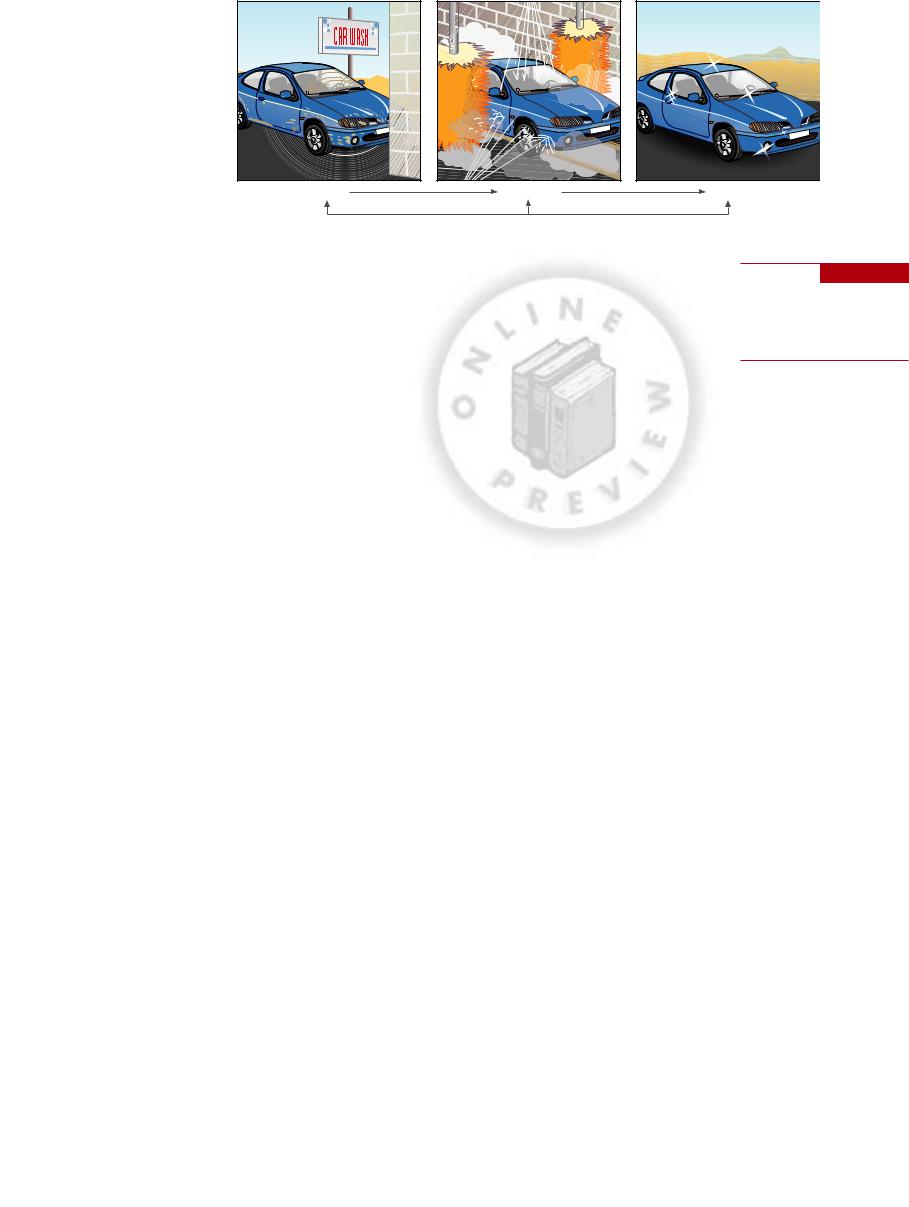
An Introduction to Information Systems | Chapter 1 |
9 |
Input |
Processing |
Output |
|
Feedback |
|
The processing mechanisms consist of first selecting which of the cleaning options you want (wash only, wash with wax, wash with wax and hand dry, etc.) and communicating that to the operator of the car wash. Note that there is a feedback mechanism (your assessment of how clean the car is). Liquid sprayers shoot clear water, liquid soap, or car wax depending on where your car is in the process and which options you selected. The output is a clean car. It is important to note that independent elements or components of a system (the liquid sprayer, foaming brush, and air dryer) interact to create a clean car.
System Components and Concepts
Figure 1.3 shows a typical system diagram—a simple automatic car wash. The primary purpose of the car wash is to clean your automobile. The system boundary defines the system and distinguishes it from everything else (the environment).
The way system elements are organized or arranged is called the configuration. Much like data, the relationships among elements in a system are defined through knowledge. In most cases, knowing the purpose or desired outcome of a system is the first step in defining the way system elements are configured. For example, the desired outcome of our system is a clean car. Based on past experience, we know that it would be illogical to have the liquid sprayer element precede the foaming brush element. The car would be rinsed and then soap would be applied, leaving your car a mess. As you can see from this example, knowledge is needed both to define relationships among the inputs to a system (your dirty car and instructions to the operator) and to organize the system elements used to process the inputs (the foaming brush must precede the liquid sprayer). Figure 1.4 shows a few systems with their elements and goals.
System Types
Systems can be classified along numerous dimensions. They can be simple or complex, open or closed, stable or dynamic, adaptive or nonadaptive, and permanent or temporary. Table 1.3 defines these characteristics.
Classifying Organizations by System Type
Most companies can be described using the classification scheme in Table 1.3. For example, a janitorial company that cleans offices after business hours most likely represents a simple, stable system because there is a constant and fairly steady need for its services. A successful computer manufacturing company, however, is typically complex and dynamic because it operates in a changing environment. If a company is nonadaptive, it may not survive very long. Many of the early computer companies, including Osborne Computer, which manufactured one of the first portable computers, and VisiCorp, which developed the first spreadsheet program, did not change rapidly enough with the changing market for computers and software. As a result, these companies did not survive. On the other hand, IBM was able
Figure 1.3
Components of a System
A system’s four components consist of input, processing, output, and feedback.
system boundary
The limits of the system; it distinguishes it from everything else (the environment).
Copyright © 2005 by Course Technology. All rights reserved.This publication is protected by federal copyright law. No part of this publication may be reproduced without prior permission in writing from Course Technology. Some of the product names and company names have been used for identification purposes only and may be trademarks or registered trademarks of their respective manufactures and sellers.
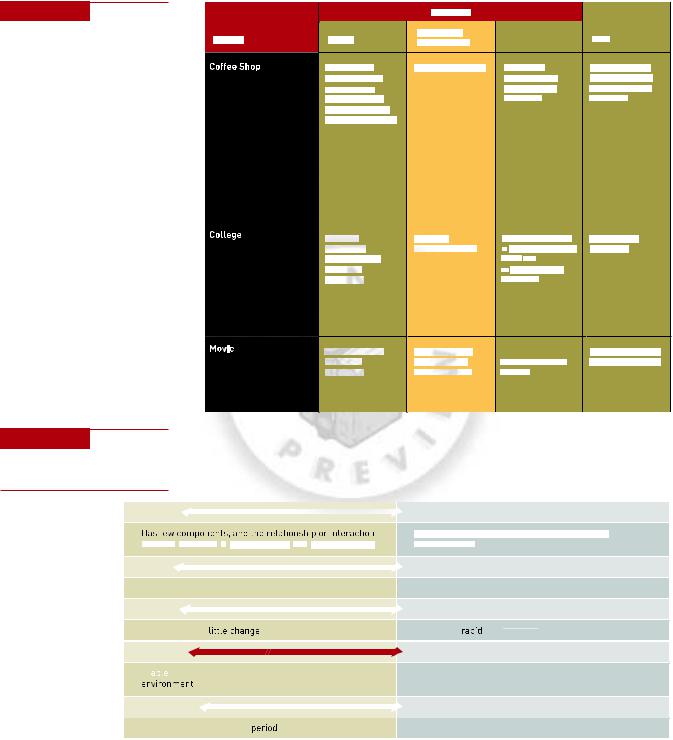
10 |
Part 1 | An Overview |
to reinvent itself from a manufacturer of large, mainframe computers to a manufacturer of all classes of computers and a software and services provider.
Figure 1.4
Examples of Systems and Their |
|
|
|
|
|
|
|
|
|
|
|
|
|
|
|
|
System |
|
|
|
|
|
|
Inputs |
|
|
|
|
|
||
|
|
|
|
|
|
|
|
|
|
|
|
|
|
||
Goals and Elements |
|
|
|
|
|
|
|
|
|
|
|
|
|
|
|
|
|
|
|
|
|
|
|
|
|
|
|
||||
(Source: © Steve Smith/Getty |
|
|
|
|
|
|
|
Coffee beans, |
|
|
|
|
|||
|
|
|
|
|
|||||||||||
Images; © Stanley Rowin / Index |
|
|
|
|
tea bags, water, |
|
|
||||||||
|
|
|
|
|
|
|
|
|
|
|
|
|
|
||
|
|
|
|
|
sugar, cream, |
|
|
|
|||||||
|
|
|
|
|
|
|
|
|
|||||||
Stock Imagery; © PhotoDisc/Getty |
|
|
|
|
|
|
|
||||||||
|
|
|
|
spices, pastries, |
|
|
|||||||||
|
|
|
|
|
|
|
|||||||||
Images.) |
|
|
|
|
other ingredients, |
|
|||||||||
|
|
|
|
|
|
|
|
|
|
|
|
|
|
||
|
|
|
|
|
|
|
|
labor, management |
|||||||
|
|
|
|
|
|
||||||||||
|
|
|
|
|
|
|
|
|
|
|
|
|
|
|
|
|
|
|
|
|
|
|
|
|
|
|
|
|
|
|
|
|
|
Elements |
|
|
|
|
|
|
|
|
|
|
|
|
||
|
|
|
|
|
|
|
|
|
|
|
|
|
|
|||
|
Processing |
|
|
|
|
|
|
|
|
|
|
|
|
|
||
|
|
|
|
|
|
|
|
Outputs |
|
Goal |
|
|
||||
|
mechanisms |
|
|
|
|
|
|
|||||||||
|
|
|
|
|
|
|
|
|
|
|
|
|
||||
|
|
|
|
|
|
|
|
|
||||||||
Brewing equipment |
|
|
Coffee, tea, |
|
|
|
Quickly prepared |
|||||||||
|
|
|
|
|
|
|
|
|
|
|
|
|
||||
|
|
|
|
|
|
|
|
pastries, other |
|
delicious coffees, |
||||||
|
|
|
|
|
|
|
|
|
|
|
|
|||||
|
|
|
|
|
|
|
|
beverages and |
|
teas, and various |
||||||
|
|
|
|
|
|
|
|
|
||||||||
|
|
|
|
|
|
|
|
food items |
|
food items |
|
|||||
Students, |
|
|
|
|
Teaching, |
|
|
|
|
|
Educated students; |
|
|
|
Acquisition of |
|||||||||
|
|
|
|
|
|
|
|
|
|
|
|
|
|
|
|
|
|
|
|
|
|
|
|
|
professors, |
|
|
research, service |
|
|
|
|
|
eaningful research; |
|
|
knowledge |
|
|||||||||||
|
|
|
|
m |
||||||||||||||||||||
|
|
|
|
|
|
|
|
|
|
|
|
|
|
|
|
|
|
|
|
|
|
|||
administrators, |
|
|
|
|
|
servic |
|
|
|
|
||||||||||||||
|
|
|
|
|
|
e to |
|
|
|
|
||||||||||||||
|
|
|
|
|
|
|
|
|
|
|
|
|
|
|
|
|||||||||
textbooks, |
|
|
|
|
|
|
|
|
|
mmunity, state |
|
|
|
|
|
|||||||||
|
|
|
|
|
|
|
|
co |
|
|
|
|
||||||||||||
|
|
|
|
|
|
|
|
|
|
|
|
|
|
|
|
|
|
|
|
|
|
|
|
|
equipment |
|
|
|
|
|
|
|
and nation |
|
|
|
|
|
|||||||||||
|
|
|
|
|
|
|
|
|
|
|
|
|
|
|
|
|
|
|
|
|
|
|
|
|
Actors, director, |
|
Filming, editing, |
Finished film |
Entertaining movie, |
|||||||
|
|
|
|
|
|
|
|
|
|
||
staff, sets, |
|
|
|
special effects, |
|
|
|
delivered to movie |
|
film awards, profits |
|
|
|
|
|
|
|
|
|
|
|||
equipment |
|
|
film distribution |
|
|
theaters |
|
|
|||
Table 1.3
Systems Classifications and
Their Primary Characteristics
Simple 
 Complex
Complex
|
|
|
|
|
|
|
|
|
|
|
|
Has many elements that are highly related and |
|
|
|
|
|
|
|
|
|
|
|
|
|
|
|
between |
|
elements |
|
is |
|
uncomplicated |
|
and |
|
straightforward |
|
interconnected |
|
|
|
|
|
|
|
|
|
|
|
|
|
|
|
Open 
 Closed
Closed
Interacts with its environment |
Has no interaction with the environment |
Stable 
 Dynamic
Dynamic
Undergoes very |
over time |
Undergoes |
and constant change over time |
Adaptive
Is to change in response to changes in the
to change in response to changes in the
Nonadaptive
Is not able to change in response to changes in the environment
Permanent 
 Temporary
Temporary
Exists for a relatively long |
of time |
Exists for only a relatively short period of time |
Copyright © 2005 by Course Technology. All rights reserved.This publication is protected by federal copyright law. No part of this publication may be reproduced without prior permission in writing from Course Technology. Some of the product names and company names have been used for identification purposes only and may be trademarks or registered trademarks of their respective manufactures and sellers.
